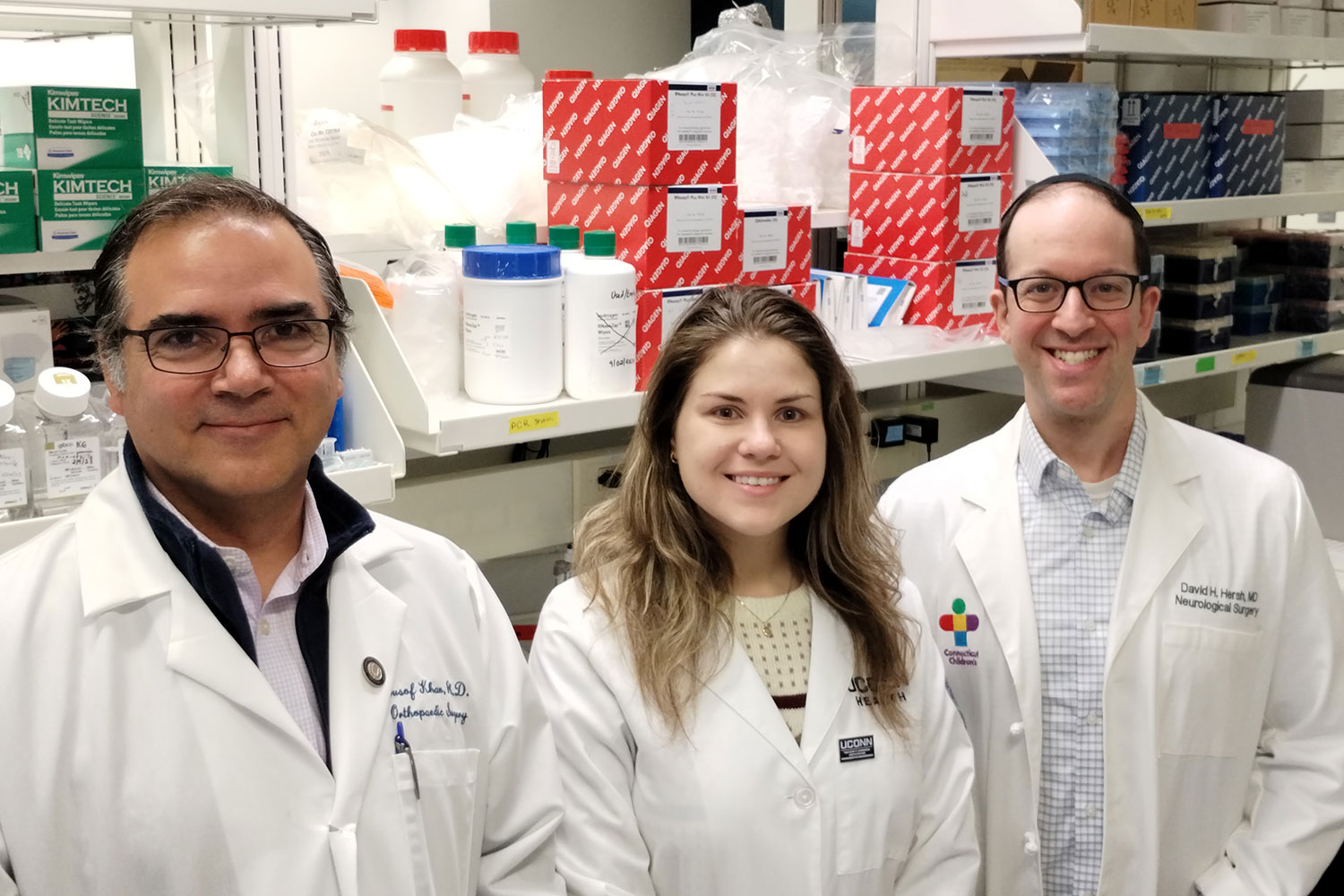
The national movement urging the use of the inexpensive, build-it-yourself “Corsi-Rosenthal” box air purifiers to easily remove unhealthy air particles from indoor community settings like classrooms and homes has been growing from the University of Connecticut to across the country – and now all the way to the U.S. Environmental Protection Agency’s (EPA) Homeland Security Division Laboratory for high-tech, advanced biochamber research testing of this device.
On Wednesday, July 26 Marina Creed, APRN, director of the UConn Indoor Air Quality Initiative, instructor of neurology in the School of Medicine, and neuroimmunology nurse practitioner at UConn Health, the academic medical center of the University of Connecticut, is taking a road trip to the EPA’s Office of Research and Development in Research Triangle Park, North Carolina to begin advanced bioaerosol chamber testing with EPA scientists of the DIY air purifiers. She is joined by UConn School of Engineering co-collaborators Kristina Wagstrom, Ph.D., associate professor in chemical and biomolecular engineering, and Misti Zamora, Ph.D., assistant professor of public health sciences at UConn School of Medicine.
For two weeks the EPA scientists will be testing the efficacy of the low-cost DIY device against the non-pathogenic bacteriophage MS2, a surrogate virus for SARS-CoV-2, the virus that causes COVID-19.

“Throughout the pandemic, the EPA has been testing much more expensive air cleaning technologies. Testing of this less-expensive device is a no-brainer,” says EPA Scientist Katherine Ratliff, whose lab will be conducting the biochamber testing of the device and the EPA will make the results publicly available.
A Student’s Letter Gets Results
UConn is bringing for testing a Corsi-Rosenthal box air filter built specifically for the EPA assessment by a class of fifth graders at Commodore MacDonough STEM Academy in Middletown. It was decorated in June with Pride rainbows and the school’s owl mascot.
One of the fifth graders, Eniola Shokunbi, who wants to be the first female African American president of the United States when she grows up, wrote and mailed Creed a letter inviting UConn to her public school, which was built almost a century ago. The student wanted to have UConn’s help to build these air filters to improve her school’s indoor air quality, reduce her fellow students’ risk of illness, and also run her own science experiment testing the effectiveness of the devices across classrooms by tracking sick absences.
“My class and I were amazed by your invention, and we wanted to see if we could try to make one ourselves,” wrote the nine-year-old in her letter. “My school was built in 1925, and it could use some improvement. Your invention could help us with that. Would you be willing to share the plans of the Corsi-Rosenthal?”
The filtration systems are named for their creators, Richard Corsi, dean of engineering at the University of California-Davis, and Jim Rosenthal, CEO of Texas-based company Tex-Air Filters.
“She sent her letter in the mail, and it was adorable,” says Creed. “UConn surprised her at her public school and taught the students about air pollution, climate change, and how with the power of their own two hands, they could create these as an innovative, fun STEM project with real world utility. We built several of these with all of the fifth-grade sections and later donated an additional twenty-five air filters for their public school. They decorated all of them for a school wide contest, including a special one for the EPA collaboration. We are taking the kids’ creation and testing it in a state-of-the-art 3,000 sq. ft. biochamber!”

Creed adds: “They can’t wait to hear the results and we can’t wait to do the testing and see the EPA’s scientific findings.”
In August, Shokunbi and her teacher will be honored for their leadership and STEM excellence at the local minor league baseball game of the Hartford Yard Goats and will be throwing out the game’s first pitch.
A DIY Solution at the Ready
You can learn online from UConn how to build your own simple, affordable DIY air purifier with just $60 worth of common hardware store supplies and 30 minutes of your time. The inexpensive, effective, plug-in air filter device is 24 x 24 in size and the replaceable filters last between 9 to 12 months. Here are UConn’s simple online directions on how to build your own DIY air filter for your home, classroom, or community setting. Also, view a how-to video by UConn School of Engineering students who build hundreds of devices each semester as part of their curriculum and as a public service donate them to help protect the Connecticut community’s indoor air quality, and the engineering students are also performing research testing of the devices.
“This low-cost DIY device is an effective and easily accessible public health intervention tool with a high public health utility to quickly improve poor indoor air quality. It can help everyone access free, clean air,” says Creed who visited the White House in September when UConn’s public Initiative fighting COVID-19 was recognized by the Office of Science and Technology Policy. During the trip, Creed gifted a DIY air filter to the White House that was assembled by Hartford Public School fifth graders that they named and decorated as “Air Force One.”
In 2021 the UConn Indoor Air Quality Initiative was formed and rallied volunteer UConn students as well as faculty and staff to begin building and donating hundreds and hundreds of air purifiers for local elementary public schools as a public intervention tool to catch bad indoor air containing virus-carrying aerosols like COVID-19. So far over 600 have been donated to local public elementary schools in the state. Also, recently UConn gifted to the public over 150 DIY air filters to help vulnerable community members mitigate the dangerous wildfire smoke particles entering their homes.

The ongoing Initiative is now even part of the UConn School of Engineering curriculum, with ongoing building and research testing of the devices by engineering students. “This public health movement is powered by students for students,” says Wagstrom of the School of Engineering. “Our UConn students are making an impact and are the future leaders.”
The ongoing collaborative, cross-campus UConn Indoor Air Quality Initiative was spearheaded by Creed to protect her immunocompromised multiple sclerosis patients and other vulnerable people in the community by building, donating, and studying the power of hundreds of these inexpensive DIY “Corsi-Rosenthal Box” air purifiers.
‘Clean Indoor Air Should Be Available to Everyone’
The Initiative is also working to understand how well DIY air purifiers clean the air. They have done tests in occupied classrooms and homes, as well as real world research of the boxes in classrooms across Connecticut.
Their research shows that the DIY devices are effective at removing the particle sizes most associated with respiratory viruses (particulates with a diameter of ≤ 2.5 µm; PM2.5). They also remove wildfire airborne particles that can cause both immediate and long-term health effects. During a recent smoke event in Connecticut, one air purifier box was able to reduce the indoor air pollution concentration by over 90% within 15 minutes. The California Department of Public Health also recommends the inexpensive DIY tool to its state’s residents as a helpful wildfire air quality intervention. Connecticut’s DPH is also supportive of this indoor air quality mitigation tool. Creed is co-principal investigator of the Clean Air Equity Response (CLEAR) Program. For the Supplemental Air Filtration for Education (SAFE) Study, Wagstrom and Creed are co-PIs with their co-investigator Zamora.

“Clean indoor air should be available to everyone. You can access clean air for only $60 worth of materials and 30 minutes of time,” stresses Creed, director of The UConn Indoor Air Quality Initiative. “It is important that we all know how to protect ourselves. Teaching our community how they can stay safe and prevent illness from exposure to bad air is critical, especially in the face of a rapidly changing climate.”
The UConn Indoor Air Quality Initiative’s cross-campus collaborators include: UConn Health and its Comprehensive Multiple Sclerosis Center, UConn School of Medicine and its Department of Public Health Sciences, UConn School of Engineering, UConn School of Nursing, Connecticut Area Health Education Center Network (CT AHEC), UConn Neag School of Education, and Connecticut Children’s.
Also, for back-to-school season, UConn plans to hold another giveaway of air filters for local teachers and school staffers to help protect and prepare them for fall and winter pollen, respiratory virus, and wildfire smoke season. Teachers can even plan a STEM lesson to build a device with their classroom students to proactively improve the indoor air they breathe together daily with lesson plans provided by the UConn Neag School of Education.
Follow UConn’s road trip to the EPA on social media.
Find out how to build your own DIY air purifier. Learn more about the UConn Indoor Air Quality Initiative.
MEDIA NOTE: The EPA testing/media event begins at 1:00pm EST on Wednesday, July 26. Interested media need to RSVP in advance to attend the event in-person by the morning of Tuesday, July 25 to: mattas-curry.lahne@epa.gov or lauren.woods@uconn.edu. A livestream of the event is being planned if possible for the social media channels above.



